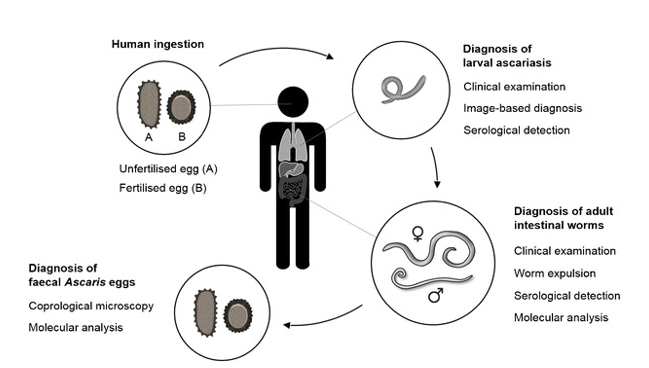Introduction:
Ascaris lumbricoides belongs to class Phasmida of Phylum Aschelminthes or Nemathelminthes. It is commonly called a roundworm, attributed to its worm-like morphology. Because A. lumbricoides eggs can withstand a variety of environmental circumstances, a large number of eggs are generated per female worm, and inadequate sanitary conditions are common, particularly in developing and undeveloped nations, infections caused by this parasite are quite common.
The adult male worm measures about 200 mm x 3 mm, while the female worm measures about 300 mm X 5 mm. The dimension of the egg is 60 µm X 40 µm.

Fig: A. lumbricoides decorticated, fertile egg in a wet mount, 400X magnification
Source: CDC 2019
Pathogenesis:
- The host’s reaction to the presence of larvae, eggs, or adult worms in a particular organ is linked to the pathophysiology of an A. lumbricoides infection.
- Larval enzymes cause lysis and mechanical damage to cells as the larvae migrate through human tissues.
- Because Ascaris‘ bodily fluid is poisonous and can cause allergic reactions, it exhibits hazardous effects. Th2 cytokine production is the result of immunological responses triggered by Ascaris infection.
- It also shows spoliative action by absorbing nutrients from the host, leading to malnutrition.
- The physical presence of A. lumbricoides in the small intestine lumen or elsewhere worms may travel, causing pathophysiologic effects in the gastrointestinal tract.
- Usually, the severity of symptoms corresponds to the worm burden. However, by migrating into a specific sphincter or duct and causing an obstructive clinical condition, a single worm might cause serious morbidity in an individual.
Laboratory diagnosis:
Clinical diagnosis is not distinguishing. It can only form base for clinical diagnosis of ascariasis. Abdominal distension, abdominal pain, nausea, vomiting, bowel obstruction, biliary or pancreatic duct blockage, appendicitis, or peritonitis occur as GI manifestations. Symptoms include dry cough, dyspnea, fever, asthma, and pneumonia when the worm migrates through the lungs.
The larvae might be found in sputum or stomach washings while migrating through the lungs and gastrointestinal tract. The eggs or adult worms are seen in the feces during the intestinal phase. Direct microscopy or wet processing of the concentrated sediment provides the best views of the eggs. The sedimentation concentration method makes it simple to recover both fertilized and unfertilized eggs. Both flotation and sedimentation techniques can be used to locate A. lumbricoides eggs.
FLOTAC technique
FLOTAC technique, which combines flotation, centrifugation, and translation, can be used detection and quantification of eggs and larvae of Ascaris. It is demonstrated that the FLOTAC method performs better than conventional copromicroscopic methods in terms of sensitivity, accuracy, and precision when it comes to identifying and measuring parasite eggs, larvae, oocysts, and cysts in samples of human and animal feces.
Antigen detection
Detection of ABA-1 antigen in stool by ELISA as the coproantigen marker was performed, which was 91.5% sensitive and 95.3% specific.
Serodiagnosis
- The generation of antibodies by A. lumbricoides varies according to exposure and infection severity, especially in high-endemic regions.
- In people who live in endemic locations, total immunoglobulin (Ig) titres are linked to worm burden. According to some research, specific Ig isotypes, like IgG4, are sensitive and specific indicators of a persistent A. lumbricoides infection.
- Standardization of Ascaris antigens, including recombinant antigens, Ascaris-associated allergens, and antigens of other ascarid species, is necessary for research and diagnostic purposes since anti-Ascaris antibodies frequently cross-react with the epitopes of other helminths.
- Compared to traditional stool microscopy, the detection of antibodies may offer a quicker and easier way to diagnose Ascaris infection.
Molecular Diagnosis
- Quick developments in molecular diagnostic technologies, like real-time quantitative PCR (qPCR) and multiplex tests, have resulted in better techniques and cheaper prices. These tools are likewise highly specific and sensitive.
- For population genetic investigations, the nuclear first internal transcribed spacer region (ITS1) DNA extraction and amplification from single Ascaris eggs has been optimized. By amplifying DNA from individual eggs, these methods may allow for the highly sensitive detection of Ascaris in stool samples.
- Multiplex qPCR assays have successfully detected A. lumbrico:ides infection alongside multiple intestinal parasites.
Prevention and Control Strategies:
- Hand washing before meals and after visiting the restroom
- Regular mass deworming with individual doses of mebendazole or albendazole
Anthelminthic medications, such as mebendazole or albendazole, are given to school-age children as part of preventive chemotherapy (PC) programs, irrespective of their infection status. - Preventive chemotherapy (PC) programs have been implemented in which anthelminthic drugs (e.g., mebendazole or albendazole) are administered to school-aged children, regardless of their infection status.


Fig: Diagnostic overview of Ascariasis
Source: Lamberton, P. H., & Jourdan, P. M. (2015).
References:
- Centers for Disease Control and Prevention. (2019). Ascariasis.
https://www.cdc.gov/dpdx/ascariasis/index.html - Lamberton, P. H., & Jourdan, P. M. (2015). Human Ascariasis: Diagnostics Update. Current tropical medicine reports, 2(4), 189–200. https://doi.org/10.1007/s40475-015-0064-9
